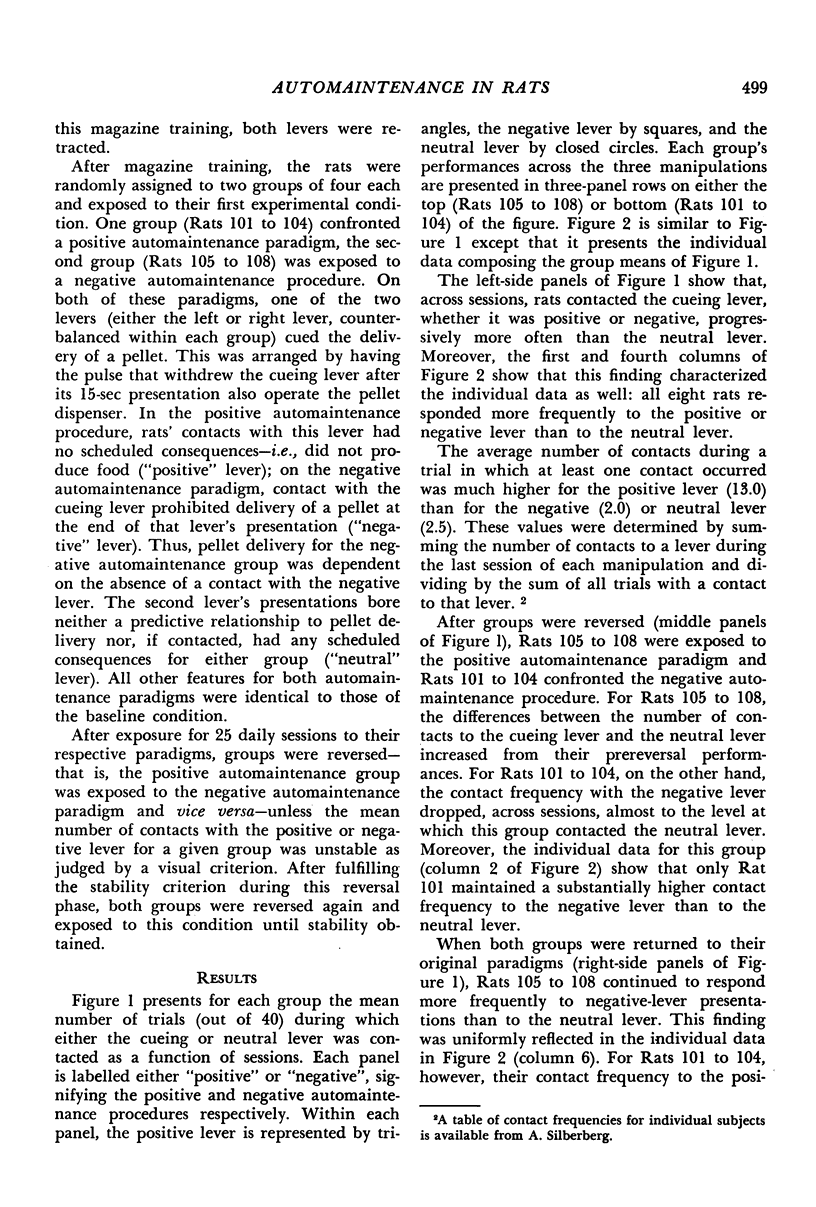Abstract
Pairing the presentations of one lever (cueing lever) with food led to the acquisition and persistence of lever contacts by rats. This behavior did not occur with a second lever, which was presented randomly with regard to food delivery. This finding obtained whether food delivery was independent of cueing-lever contacts (positive automaintenance) or dependent on the absence of cueing-lever contacts (negative automaintenance). The general findings were: (1) cueing-lever contacts on the positive automaintenance procedure occurred on a higher proportion of trials and at higher rates when contacts occurred than on the negative automaintenance procedure; (2) instances of the cueing lever's failure to support responding were more frequent on the negative than the positive automaintenance procedure; and (3) the topography and median contact duration of positively automaintained responding differed from negatively automaintained responding. These findings agree substantially with the automaintenance literature on pigeons, suggesting that similar processes may characterize automaintained responding in both pigeons and rats.
Full text
PDF









Selected References
These references are in PubMed. This may not be the complete list of references from this article.
- Brown P. L., Jenkins H. M. Auto-shaping of the pigeon's key-peck. J Exp Anal Behav. 1968 Jan;11(1):1–8. doi: 10.1901/jeab.1968.11-1. [DOI] [PMC free article] [PubMed] [Google Scholar]
- DAVIS J. D. Electronic drinkometer and recorder. J Exp Anal Behav. 1961 Apr;4:145–147. doi: 10.1901/jeab.1961.4-145. [DOI] [PMC free article] [PubMed] [Google Scholar]
- Gamzu E. R., Williams D. R. Associative factors underlying the pigeon's key pecking in auto-shaping procedures. J Exp Anal Behav. 1973 Mar;19(2):225–232. doi: 10.1901/jeab.1973.19-225. [DOI] [PMC free article] [PubMed] [Google Scholar]
- Gamzu E., Schwam E. Autoshaping and automaintenance of a key-press response in squirrel monkeys. J Exp Anal Behav. 1974 Mar;21(2):361–371. doi: 10.1901/jeab.1974.21-361. [DOI] [PMC free article] [PubMed] [Google Scholar]
- Gamzu E., Schwartz B. The maintenance of key pecking by stimulus-contingent and response-independent food presentation. J Exp Anal Behav. 1973 Jan;19(1):65–72. doi: 10.1901/jeab.1973.19-65. [DOI] [PMC free article] [PubMed] [Google Scholar]
- Hursh S. R., Navarick D. J., Fantino E. "Automaintenance": the role of reinforcement. J Exp Anal Behav. 1974 Jan;21(1):117–124. doi: 10.1901/jeab.1974.21-117. [DOI] [PMC free article] [PubMed] [Google Scholar]
- Jenkins H. M., Moore B. R. The form of the auto-shaped response with food or water reinforcers. J Exp Anal Behav. 1973 Sep;20(2):163–181. doi: 10.1901/jeab.1973.20-163. [DOI] [PMC free article] [PubMed] [Google Scholar]
- Peterson G. B., Ackilt J. E., Frommer G. P., Hearst E. S. Conditioned Approach and Contact Behavior toward Signals for Food or Brain-Stimulation Reinforcement. Science. 1972 Sep 15;177(4053):1009–1011. doi: 10.1126/science.177.4053.1009. [DOI] [PubMed] [Google Scholar]
- Schwartz B., Williams D. R. The role of the response-reinforcer contingency in negative automaintenance. J Exp Anal Behav. 1972 May;17(3):351–357. doi: 10.1901/jeab.1972.17-351. [DOI] [PMC free article] [PubMed] [Google Scholar]
- Schwartz B., Williams D. R. Two different kinds of key peck in the pigeon: some properties of responses maintained by negative and positive response-reinforcer contingencies. J Exp Anal Behav. 1972 Sep;18(2):201–216. doi: 10.1901/jeab.1972.18-201. [DOI] [PMC free article] [PubMed] [Google Scholar]
- Sidman M., Fletcher F. G. A demonstration of auto-shaping with monkeys. J Exp Anal Behav. 1968 May;11(3):307–309. doi: 10.1901/jeab.1968.11-307. [DOI] [PMC free article] [PubMed] [Google Scholar]
- Williams D. R., Williams H. Auto-maintenance in the pigeon: sustained pecking despite contingent non-reinforcement. J Exp Anal Behav. 1969 Jul;12(4):511–520. doi: 10.1901/jeab.1969.12-511. [DOI] [PMC free article] [PubMed] [Google Scholar]


